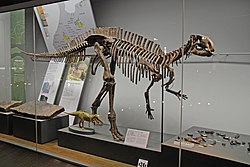Top Qs
Timeline
Chat
Perspective
Kitadani Formation
Stratigraphic unit in Japan From Wikipedia, the free encyclopedia
Remove ads
The Kitadani Formation (Japanese: 北谷層 Kitadani-sō) is a unit of Lower Cretaceous sedimentary rock which crops out near the city of Katsuyama in Fukui Prefecture, Japan, and it is the primary source of Cretaceous-aged non-marine vertebrate fossils in Japan. Most, if not all, of the fossil specimens collected from the Kitadani Formation are reposited at the Fukui Prefectural Dinosaur Museum.[2]
The Kitadani Formation is a unit within the Tetori Group, a major sequence of Lower Cretaceous rocks that is distributed across Fukui, Ishikawa, and Gifu prefectures of western-central Honshu. The Tetori Group exhibits marked lateral variation, and the Kitadani Formation is only present in Fukui Prefecture.[1] The Kitadani Formation comprises interbedded tuffs, sandstones, and shales and reaches a maximum thickness of approximately one hundred meters (~328 feet).[1] It conformably overlies the Akaiwa Formation and is unconformably overlain by the Omichidani Formation.[3] The Kitadani Formation is significant because it is the major source of dinosaur fossils in Japan and because of Japan's unique position along the northeastern margin of Eurasia during the Early Cretaceous.
Remove ads
Geology
Summarize
Perspective
The Kitadani Formation is a unit within the Tetori Group, a Lower Cretaceous sequence of predominantly sedimentary rock which crops out in the Fukui, Ishikawa, and Gifu prefectures of west-central Honshu, Japan in the region surrounding Mount Haku.[1][4]
The formations present within the Tetori Group vary laterally, and the Kitadani Formation crops out only in the Kuzuryū River district of Fukui Prefecture. In this region, the sequence comprises, in ascending stratigraphic order: Gomijima Formation, the Kuwajima Formation, the Akaiwa Formation, and Kitadani Formation.[1] The Kitadani Formation comprises alternating horizons of red-brown tuffs, blackish shales and sandstones, and thin coal beds. The sandstones within the Kitadani Formation are light gray and green and range in clast size from fine to coarse. The type section of the Kitadani Formation occurs along the Nakanomatadani branch of the Takinami River near the city of Katsuyama, where it is approximately 100 m (~328 feet) in thickness. The Kitadani Formation conformably overlies the Akaiwa Formation and is unconformably overlain by the Omichidani Formation.[1]
The palaeoclimate during the deposition of the formation was noticeably warmer and drier than that of the older Kuwajima and Okurodani Formations, as evidenced by oxygen isotope records as well as by the presence of crocodylomorph fossils in the former in contrast to their absence in the latter.[5]
The Kitadani Formation has had varying nomenclature throughout the history of its study.[1] In the early stratigraphic literature on the Tetori Group, the Kitadani Formation was variably referred to as the "Lower part of the Omichidani Formation",[6] the "Chinaboradani Alternation of Tuff, Shale, and Sandstone",[7] the "Kitadani Alternation of Sandstone, Shale, and Tuff",[8] and simply the "Kitadani Alternation"[9] prior to its designation as a formation.[1]
Remove ads
Age
The Kitadani Formation was biostratigraphically dated to the late Barremian and early Aptian ages of the Early Cretaceous Epoch in 2002 based upon the presence of the freshwater bivalve Nippononaia ryosekiana.[10] In 2005, part of the Kitadani Formation was biostratigraphically dated to the Barremian Age based upon the occurrence of the charophyte gyrogonite Clavator harrisii reyi in association with other charophytes.[11] These biostratigraphic age assignments are supported by zircon fission track radioisotopic ages of tuff, which date the Kitadani Formation to 127-115 Ma.[12] However, the age of the overlying lower Akaiwa Formation was estimated around 121.2±1.1 Ma based on U-Pb zircon dating, so the age of the Kitadani Formation is more likely to be late Aptian.[13][14]
Remove ads
Fossil assemblage
Summarize
Perspective
The Kitadani Formation preserves a diverse assemblage of plant fossils; invertebrate fossils; and vertebrate body and trace fossils, including mammals, turtles, crocodylomorphs, and dinosaurs. Many vertebrate specimens from the Kitadani Formation are incomplete and poorly preserved, so taxonomic diversity is likely higher than it seems.
Plant fossils
The plant fossil assemblage of the Kitadani Formation is characterized by a rarity of ferns and an abundance of cycadales and conifers represented mostly by cones and shoots.[15] A palynological study in 2013 resulted in the identification of greater than 40 species of spores, pollen grains, and plant fragments from the Kitadani Formation representing gymnosperms, freshwater algae, and epiphyllous fungus; however, no angiosperm pollen was identified.[16] Branches of the conifer Brachyphyllum obesum have been recovered, which was interpreted to represent the warming and possible drying of the climate toward the upper Tetori Group.[17] This interpretation is supported by the lack of plants from lower in the Tetori Group, such as ginkgos, in the Kitadani Formation.[18]
Invertebrate fossils
The invertebrate fossil assemblage of the Kitadani Formation mostly comprises freshwater and brackish water bivalve and gastropod mollusks.[19]
Vertebrate fossils
Actinopterygii
Mammaliaformes
Testudines
Turtles are represented mostly by shell fragments within the Kitadani Formation.[22][23]
Crocodylomorpha
A nearly complete skeleton of goniopholidid has been discovered from the Kitadani Formation, but this material remains undescribed.[24]
Dinosauria
Dinosaurs are among the most well-known vertebrate taxa from the Kitadani Formation. Taxa from all three major dinosaurian clades — Theropoda, Sauropodomorpha, and Ornithischia — have been recovered.[25]
Ichnofossils
Undescribed tracks of ankylosaurs and sauropods have been discovered from the Kitadani Formation.[35]
Eggs
Remove ads
See also
References
Wikiwand - on
Seamless Wikipedia browsing. On steroids.
Remove ads












